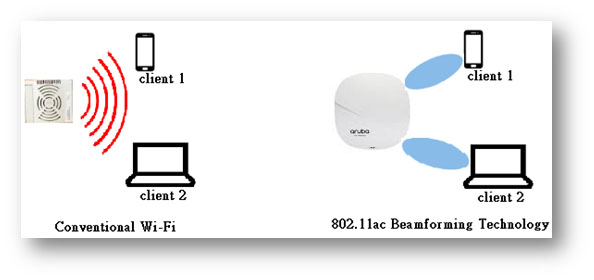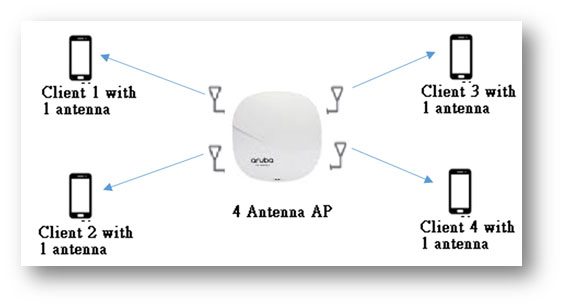CityU Wireless LAN Upgrade
- Offers higher speed and better performance
- Supports 160MHz-wide (or 80MHz+80MHz) channels in the 5 GHz band to allow higher throughput between two wireless devices and enables high-speed delivery of large files and data access.
- Supports four spatial streams to increase the amount of signals that can be transmitted simultaneously from one device using different antennas.
- Uses 256 Quadrature Amplitude Modulation (QAM) to achieve higher raw-data speed.
With the above technologies, Wave 2 can provide up to 3.47 Gbps data throughput. Since 802.11ac has the headroom to support up to eight spatial streams, therefore the maximum throughput can go up to 6.93 Gbps theoretically. Below is the speed comparison of different standards:
Frequency Band Theoretical maximum rate 802.11ac Wave 2 5GHz 3.47 Gbps 802.11n 2.4GHz or 5GHz 600 Mbps 802.11g 2.4GHz 54 Mbps
- Uses explicit beamforming technology to improve Wi-Fi reception and reduce interference by focusing Wi-Fi signals directly to an intended client devices and vice versa.

Beamforming improves wireless bandwidth utilisation, and can increase the performance of wireless networks at medium ranges. It also enables the support of MU-MIMO technology.
- Supports downlink MU-MIMO
MU-MIMO stands for “Multi-User, Multiple-Input, Multiple-Output”. This is the multi-user version of MIMO technology that allows an AP with four antennas to simultaneously transmit data to multiple MU-MIMO capable devices (at most four devices such as smartphones, each with one antenna) to achieve more efficient use of the spectrum and greatly improve the overall wireless network capacity. The MU-MIMO boosts user capacity and ensures better experience for end users under the extremely high device-density environments.

Unfortunately, the uplink MU-MIMO that allows multiple client devices to transmit data to the access point at the same time is not implemented in the 802.11ac Wi-Fi standard. Therefore only one client device is allowed to send data to the AP at any instant. Uplink MU-MIMO will be implemented in the next-generation Wi-Fi specification 802.11ax.
The 802.11ac standard brings many new improvements. It is designed for high speed, more stable and high density wireless network. The new technologies used can significantly improve the performance of bandwidth and latency-sensitive applications such as massive data transfer and video streaming. Users will need to use 802.11ac devices to take full advantage of the new features.